BEYOND BOUNDARIES
HISTORICAL ART BY AND OF PEOPLE OF COLOR
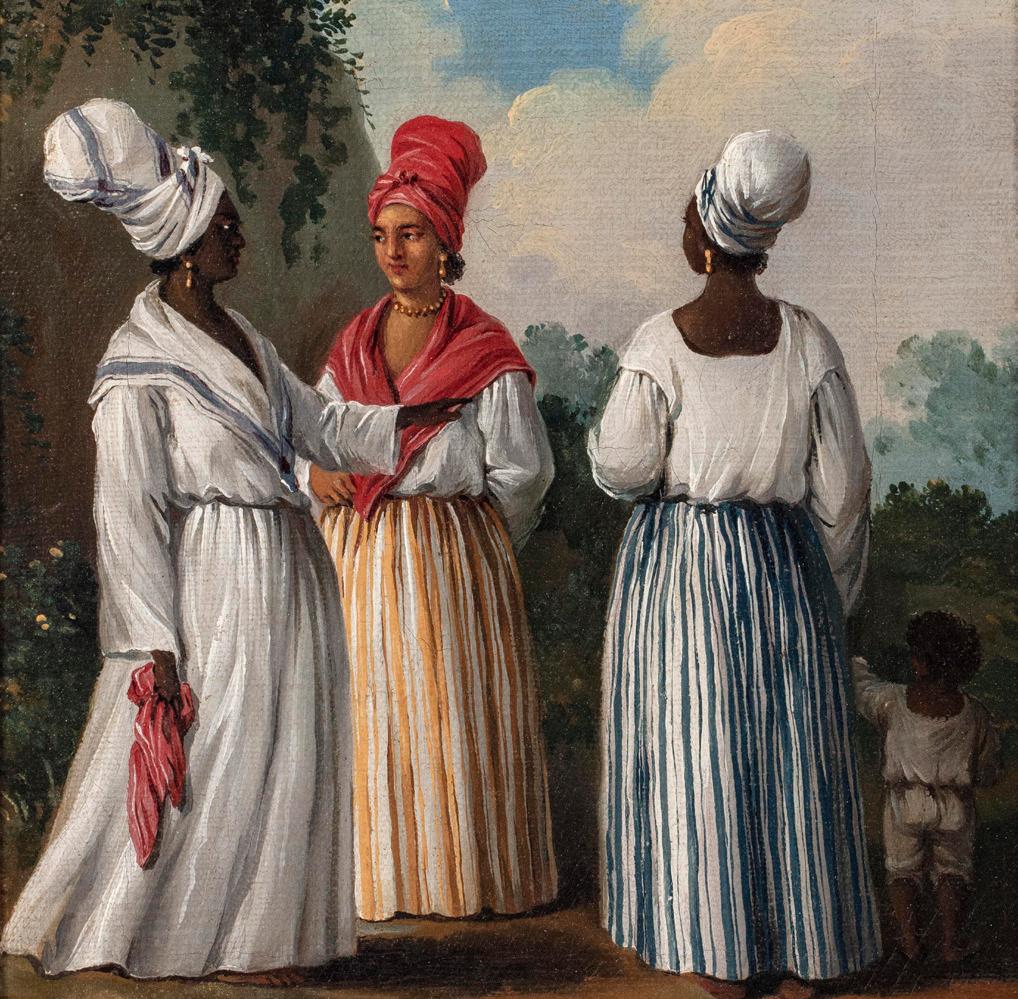
Beyond Boundaries: Historical Art By and Of People of Color
CATALOGUE BY Dominic Ferrante with Robert B. Simon
ROBERT SIMON FINE ART
© 2022 Robert Simon Fine Art, Inc.
ROBERT SIMON FINE ART 22 EAST 80TH STREET · NEW YORK · NY · 10075 TEL: 212·288·9712 FAX: 212·202·4786 BY APPOINTMENT AT: SATIS HOUSE 53 TOWER HILL ROAD EAST · TUXEDO PARK · NY · 10987 TEL: 845·351·2339 FAX: 845·351·4332
back
Free
Front and
covers: Details of Agostino Brunias,
Women of Dominica with a Child and Spanish or Spanish Colonial, Saint Benedict of Palermo.
B.
RBS@ROBERTSIMON.COM DOMINIC FERRANTE JR. DFJ@ROBERTSIMON.COM
Photography by Glenn Castellano
ROBERT
SIMON
Full catalogue entries and supplemental photographs of each work are available on our website: www.robertsimon.com/beyond-boundaries.
High-resolution digital photographs, condition reports, and prices are available upon request.

Introduction
Diversity is a crucial issue in the contemporary art world today. But what of the art of the past? “Beyond Boundaries” brings to light an array of paintings, sculptures, and works of art from the 17th to 19th centuries, from Europe and the Americas, that explore subjects and makers often overlooked in traditional art history. But unlike many thematic exhibitions, there is no overriding theory that is being promoted, nor is the exhibition grounded on an underlying social or political philosophy. Rather we have attempted to explore diversity simply by exhibiting diverse works of art—each chosen as it in some way illustrates an aspect of the historical past, some surprising and empowering, others uncomfortable or disturbing. In this brief catalogue we have furnished summary information about these works, many of which are little known, at least within the confines of the mainstream art market. And we have attempted to provide some context about them, so they can better be appreciated by the contemporary viewer, both aesthetically and as culturally significant works. It is with pleasure that we take you beyond boundaries.
We gratefully acknowledge colleagues and friends who have assisted in the loan of works for this exhibition: Arader Galleries, Robilant & Voena, and The Shin Collection.
Robert B. Simon
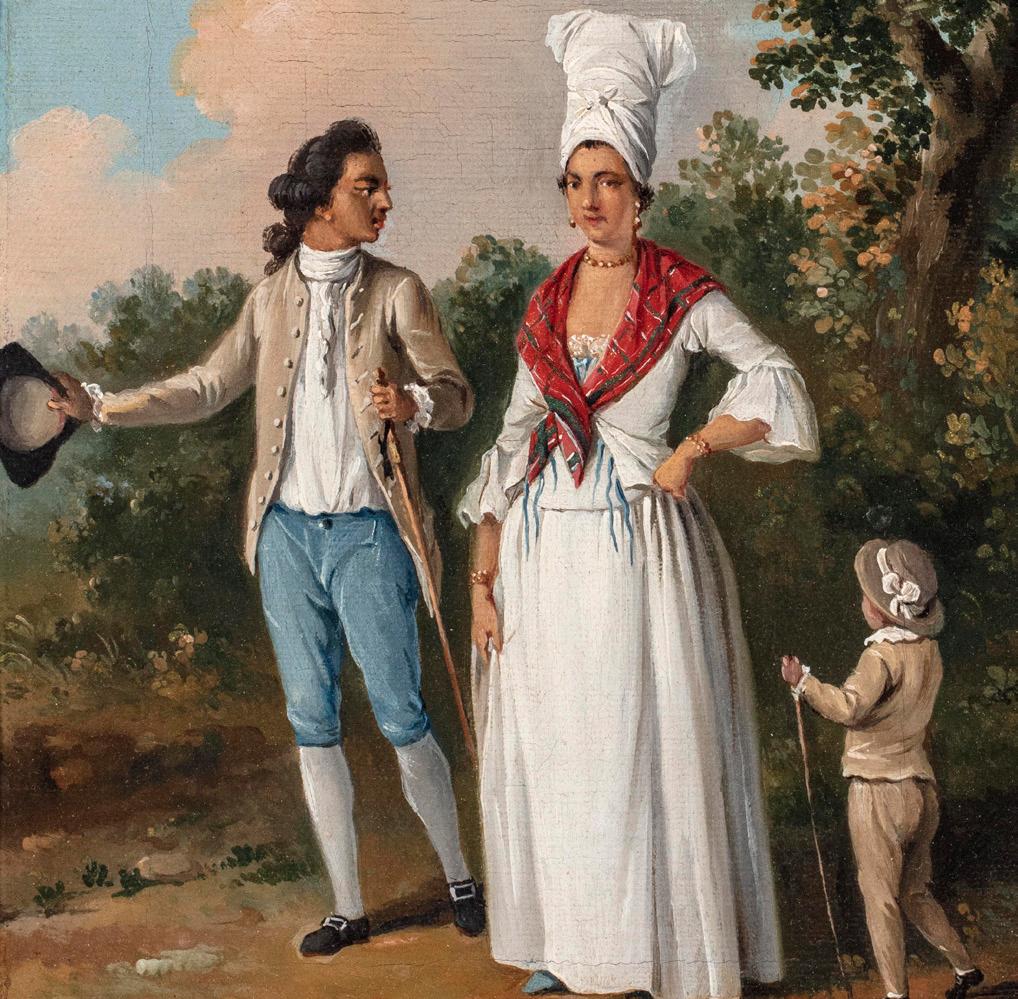
GOBELINS TAPESTRY MANUFACTORY, Woven 1687–1688
The Kongolese Dignitary carried by Two Porters
Wool and silk weft
15 feet 4 inches x 10 feet 8 inches (approx. 467 x 325 cm)
The Anciennes Indes tapestries are celebrated not only as masterpieces from the Gobelins Manufactory, but as both milestones of the Age of Enlightenment and pioneering representations of people beyond the European continent. The two examples presented here are especially significant as they come from the first edition of eight woven for Louis XIV in 1687–1688.
The tapestry series was based on cartoons by Albert Eckhout and Frans Post commissioned by Johan Maurits, the governor of the Dutch colony in Brazil. Maurits had gifted the cartoons to Louis XIV, writing that in these images one could see the marvels of Brazil without crossing the ocean. The Kongolese Dignitary carried by Two Porters is connected with the arrival of five ambassadors from the Kingdom of Kongo (present day Northern Angola and Western Congo) to Mauritsstad (now Recife) in 1642–1643. Eckhout recorded the appearance of these dignitaries, each high-ranking nobles, in several related oil studies preserved in his Libri picturati. In the tapestry, the central figure carried in a hammock is caparisoned with Kongolese dress and ornament: the red and green mpu cap decorated with shells, yellow brocade wrap tied with a red dyed cloth, folded animal pelt, richly patterned umbrella decorated with feathers, strands of coral beads, and the metal chain with a cross (Kongo was a Christian kingdom from the 15th century). The choice of subject of this work is a particularly fascinating one, in that it emphasized the political ties between the Dutch colonies in Africa and Brazil, but sidelined the realities of the enslaved African labor that sustained the Dutch in the New World. In fact, the Kongolese ambassadors traveled to Brazil with 200 enslaved people, among which were likely the two porters depicted in the tapestry. They are here compositionally and literally marginalized, depicted along the border of the pictorial frame, one turned away from the viewer and the other’s face half-disguised by the pole to which the hammock is tied.
1

2
GOBELINS TAPESTRY MANUFACTORY, Woven 1687–1688
The Mapuche Lancer on Horseback
Wool and silk weft
15 feet 1 inch x 11 feet 3 inches (approx. 458 x 344 cm)
One of the most intriguing aspects of these tapestries is the prominent depiction of peoples that one might not initially expect Albert Eckhout, the primary author of the cartoons, to have encountered in the Dutch colony in Northeastern Brazil. The Mapuche Lancer on Horseback depicts a South American native—Chilean rather than Brazilian—accompanied by an African groom standing beside another horse. The horseman holding a lance faces away from the viewer, putting on full display his red and yellow poncho, dress local to the Andes. Native also to the region are the two llamas laying in the long grass in the foreground. Given the presence of Andean people and animals, it has been though that Eckhout participated in the Dutch expedition to Chile of 1642–1643. The fleet sailed from Mauritsstad with the goal of capturing Valdivia, a former Spanish stronghold on the Pacific coast. They briefly succeeded, renaming the town Brouwershaven, but soon abandoned their settlement after conflicts with the indigenous people, the Mapuche. The Mapuche had adopted the horse after the Spanish introduced them to the New World, and a 17th-century Spanish chronicle records the adeptness of Mapuche riders at wielding lances, describing them as “grandes hombres de a caballo.” The principal figure in the tapestry is almost certainly a Mapuche warrior, his horse equipped with tack that must have been specific to this native group. The simple saddlecloth, cane stirrups, and distinctive bridle are here juxtaposed with the European bridle and brocaded silk cloth draped over the dappled horse in the foreground. Today these tapestries serve both as extraordinary documents of a much-changed world and captivating images of the people, flora, and fauna that inhabited it. Rather than presenting exoticizing depictions of the people and places portrayed, Eckhout composed an imaginative and sympathetic vision of Brazil informed by his firsthand experience of the peoples and places he encountered during his time in the Dutch colony.
3
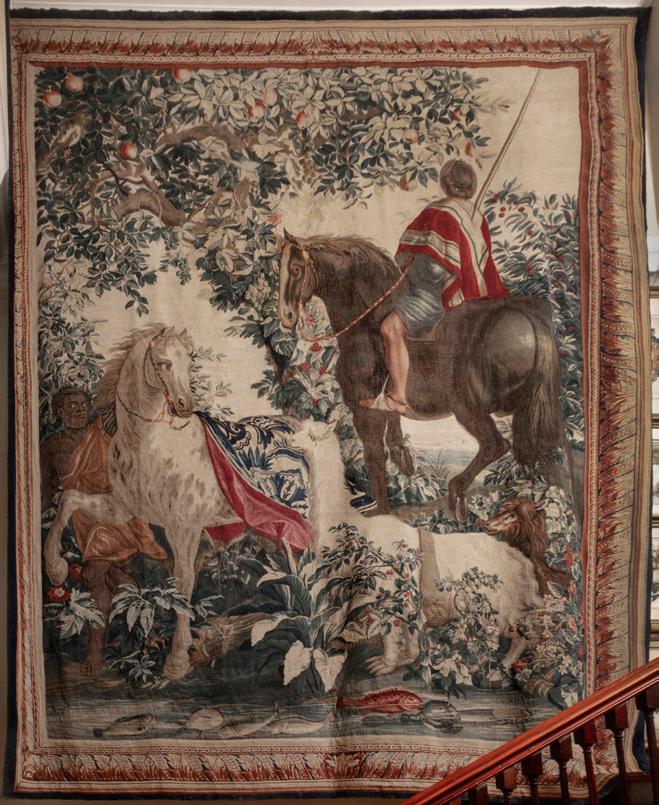
4
PERUVIAN OR BOLIVIAN SCHOOL, 18th Century
The Vision of Saint James Triumphing Over the Inca
“Santiago Mataindios”
Oil on canvas
40 x 33 ¾ inches (101.6 x 85.7 cm)
The subject of Saint James battling indigenous warriors, known as Santiago Mataindios, is the New World counterpart and response to the well-known Spanish iconography of Saint James triumphing over the Moors, Santiago Matamoros. The origin of Santiago Matamoros imagery can be traced to the legend that the Apostle Saint James miraculously appeared on horseback at the (mythical) Battle of Clavijo in the 9th century, leading the Spanish to victory over the Muslims in their campaign for the reconquest of Spain. By the mid-16th century, Spanish Colonial images of Saint James presented him in this distinctly New World guise, at war with either Aztec or Inca combatants. This new iconography is tied to a legend that Santiago intervened on behalf of the Spanish during the siege of Cuzco by Manco Inca Yupanqui in 1536–1537. In our painting, James appears riding a white horse, brandishing a sword against several Inca wearing feathered headdresses and attired in traditional geometric-patterned tunics known as uncu. They display a range of expressions from awe to defiance of the clearly belligerent but placidly-featured saint—disparate from most representations of the theme which show the native fighters passive or subjugated. The principal figure at left draws his bowstring and points an arrow directly at the saint, although the tip is conspicuously hidden behind his horse. Interestingly, Saint James became equated in Peru with the Inca god of lightning, Illapa, as a protector of Christians in the New World, since he was said to have appeared as a flash of lightning at the siege of Cuzco. This conflation may be hinted at in this painting, as Saint James’ horse displays a sun-like motif with emanating rays in the center of the browband on its bridle recalling depictions of Inti, the Incan solar deity. Our work is painted in an unusually sophisticated style, one which can be localized in the Altiplano, the Andean plateau, which extends across southern Peru and into northern Bolivia.
5

6
Saint Benedict of Palermo
Polychrome wood
29 ½ x 15 x 12 inches (74.9 x 38.1 x 30.5 cm)
Saint Benedict of Palermo (ca. 1524–1589) was the first Black saint canonized in modern times. Born in a village near Messina to enslaved Christians of Ethiopian origin, he was manumitted when young, but remained uneducated. He was working as a farm hand when, at the age of twenty-one, he met an itinerant noble ascetic and joined his group of devout hermits. Following the dissolution of their hermitage, Benedict entered the Franciscan order, becoming a lay brother at the Monastery of Santa Maria di Gesù near Palermo. His initial duties there were modest ones, preparing food in the kitchen and sweeping the monastery floors, but he was eventually appointed Guardian and Master of the Novices at the Monastery, both extraordinary positions in light of his evident illiteracy and race. Miracles attributed to Benedict accompanied his humble and devout life, and his path to sainthood began soon after his death in 1589. Although he was not formally canonized until 1807, Benedict was broadly venerated from the 16th century on, particularly in Spain and Portugal, and later in the New World—especially among confraternities of both enslaved and freed people of African origin. Our polychrome sculpture depicts Benedict in a finely striped Franciscan habit edged with gold and belted by a gilt cord. He holds aloft a crucifix while grasping a flaming heart banded with thorns, which symbolically alludes to the ecstatic event described at his death when his heart burst from his chest to be united with Christ. Several 18thcentury sculptures of related iconography are known in Iberian churches. Like our sculpture, they invariably depict the saint at a youthful age with a dark complexion devoid of shading, standing in a relatively static pose, but with an intense gaze, here enlivened by the sculptor’s use of glass eyes.
SPANISH SCHOOL, late 18th Century
7
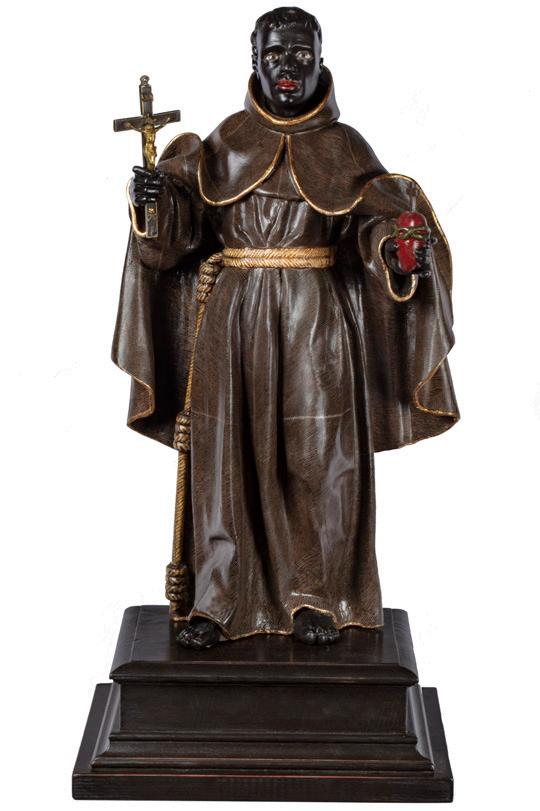
8
SPANISH OR SPANISH COLONIAL, 18th Century
Saint Benedict of Palermo
Signed or inscribed, and dated on the reverse: Feccid. Franc.o Benito Gonzs Missa / en vio Molinos de tuy A.o 1747
Oil on canvas
50 ¼ x 35 ¾ inches (127 x 91 cm)
Paintings depicting Saint Benedict of Palermo—the patron saint of African Americans, African missions, and enslaved people—are extremely rare. The present canvas appears to be unique in illustrating episodes from his life in addition to a full-length depiction of the saint. The composition, with its iconic central figure surrounded by vignettes framed in baroque roundels, recalls that of 18thcentury Mexican paintings, such as the Virgin of Guadalupe with Scenes of Her Miracles. However, despite an original inscription giving a date of 1747 and a possible author or dedicatee, the precise origin of the painting remains unresolved. The figure of Benedict—with his lambent aureole, tools of mortification at his feet, and inscription at the base—derives from a Spanish engraving of 1743, while the narrative scenes have no visual precedent. These depict miracles attributed to the saint. Two involve the materialization of food: the appearance of live fish in two Talavera Poblana bowls of water left out overnight (center right), and a dinner cooked and served by angels at the saint’s behest (upper left). Others record miracles of levitation, transformation, and reanimation. A charming scene is at the lower right: the saint gently asks two cats to relinquish the food they have stolen from the monastery’s pantry. Benedict’s cause for sainthood was supported and amplified by the Church and the Spanish monarchy, as each sought to evangelize people of African descent across several continents. That endeavor was hugely successful as devotion to the saint by people of all races forms a vibrant part of both religious and popular culture in the Americas to this day.
9

10
AGOSTINO BRUNIAS
(Rome ca. 1730 – 1796 Roseau)
Free Men and Women of Dominica and an Indigenous Family of St. Vincent
Six paintings, each oil on canvas
11 ¾ x 9 ⅛ inches (29.9 x 23 cm)
Agostino Brunias’s paintings are among the most notable examples of European depictions of Black and mixed-race people in the New World. They are particularly distinguished as recording a culture that was largely free from the constraints of racial hierarchies endemic in most colonial territories centered on plantation agriculture. Although little was known of his life until recently, including his proper name and country of origin, it is now certain that Brunias was born and trained in Rome, beginning his career as a Grand Tour painter, before moving to England. In 1764 he traveled to the British West Indies, eventually taking up residence in Dominica, one of the Windward Islands of the Caribbean. Brunias traveled widely in the region, and his portrayal of local society—the main subjects of his paintings—provides an invaluable record of both indigenous and burgeoning Creole culture. The six works presented here form a rare, complete set of Brunias’s characteristic small-scale genre scenes, each produced on identically sized canvases and remarkably surviving in their original frames. They include several depictions of women engaged in conversation, a group of women bathing in a stream, a confidently posed woman promenading with her fashionably dressed husband and child, as well as a native family from the island of St. Vincent. Each are characterized by Brunias’s vivid palette, as well as his sensitive and detailed rendering of local dress. Noteworthy is the nuanced treatment of the subtle gradations in skin color, as well as the social distinctions that inform the groupings and interrelations of the figures within individual works. Brunias’s paintings not only provide significant insight into how the peoples depicted lived and were viewed in their own time, but also raise important questions about how these works may have influenced attitudes of viewers in the Caribbean, in continental Europe, and in Britain, where many of his principal patrons and collectors resided.
11
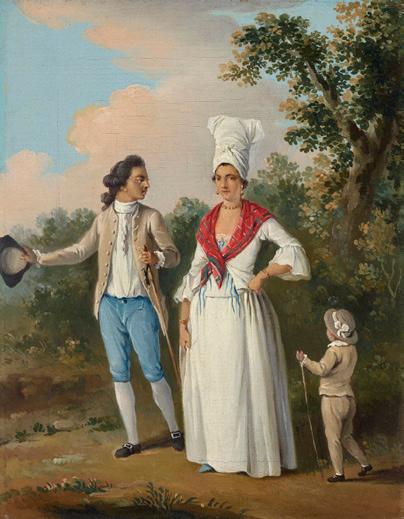

12
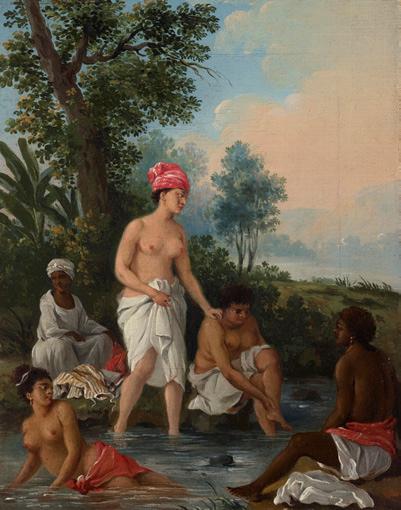
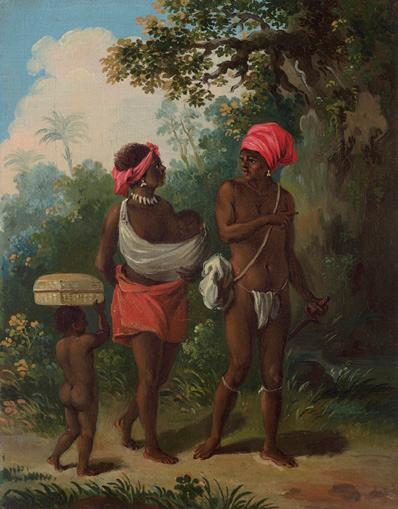
13


14
PERUVIAN, CUZCO SCHOOL
, 18th Century Virgin of Montserrat Oil on canvas
18 x 14 ⅝ inches (45.7 x 37.1 cm)
The hierarchal composition of this painting, with its outsized Virgin and Child seated in a landscape before a looming mountain, is one engaging aspect of this fascinating example of the cultural amalgamation that defines much of Spanish Colonial art. Painted in 18th-century Peru, it is a depiction of the Virgin of Montserrat, a 12th-century carved wood and gilt sculpture in Catalonia that was one of the most well-known and venerated Black Madonnas in Europe. Interestingly, it was not until at least the 16th century that the skin of the Virgin of Montserrat was described as black. In general, the miraculous sculptures that came to be known as Black Madonnas did not have racial or ethnic connotations when made. Some darkened naturally, others were treated with tinted varnishes, while a few seem to have been deliberately colored in the late medieval and early modern periods to make them appear older and thus acquire additional qualities of authenticity and authority. However, these works gained new significance in later centuries as a religious and cultural reference for people of color. In our painting the figures of the Virgin and Child directly echo the arrangement of the original sculpture, but they have been transformed from their medieval abstract forms into accessible human beings, imparting new meaning to the color of their skin. That Colonial Peru was in good part inhabited by a dark-complexioned, mixedrace populace (including many artists of the Cuzco School) makes both the naturalistic features and the skin color of the Virgin and Child especially consequential. Like many New World paintings of the period, the design of this work is based on a monochromatic European print, but through the addition of color, the anonymous artist has deepened its relevance to his audience.
15

16
JOSÉ DE LA CRUZ
(Mexico, 18th Century)
Virgin of Guadalupe
Signed and dated, lower right: Joseph de la Cruz f.t / Año de 88
Oil on canvas
81 x 54 inches (205.7 x 137.1 cm)
This grand canvas of the Virgin of Guadalupe records the 1531 vision of Juan Diego, a Chichimec peasant and Christian convert at Guadalupe, just outside of Mexico City. According to the legend, the Virgin Mary appeared as a young dark-skinned woman to Juan Diego Cuauhtlatoatzin (his full name) and spoke to him in his native Nahuatl tongue. The Virgin directed him to ask the bishop of Mexico to build a church in her honor at the site of their encounter. The bishop required proof of this miraculous vision, so Juan Diego petitioned the Virgin for assistance. She reappeared and instructed him to pick roses, which had bloomed despite its being winter, that he then gathered into his tilmàtli—a type of native garment worn as a mantle. When Juan Diego returned to the bishop and opened his tilmàtli, he revealed the now universally recognizable standing figure of the Virgin imprinted on the fabric. In our painting that image appears at center, surrounded by vignettes illustrating episodes from the legend that are connected by vines of roses referencing those picked by Juan Diego. The cult of the Virgin of Guadalupe spread rapidly in the New World, particularly among the population of recently converted indigenous people. That the Virgin spoke in a local language and had dark skin was viewed as confirming the spiritual worthiness of indigenous Americans and underscoring the universality of Christianity. Today the Virgin of Guadalupe remains the national icon of Mexico and is venerated worldwide. Our painting is a rare signed and dated version by José de la Cruz, an artist known to have painted large-scale images of the Virgin of Guadalupe for export. Other examples by him are recorded in Seville and the Canary Islands; our painting in fact comes from the Ligurian town of Santo Stefano d’Aveto, Italy, which has long had a special devotion to the image.
17
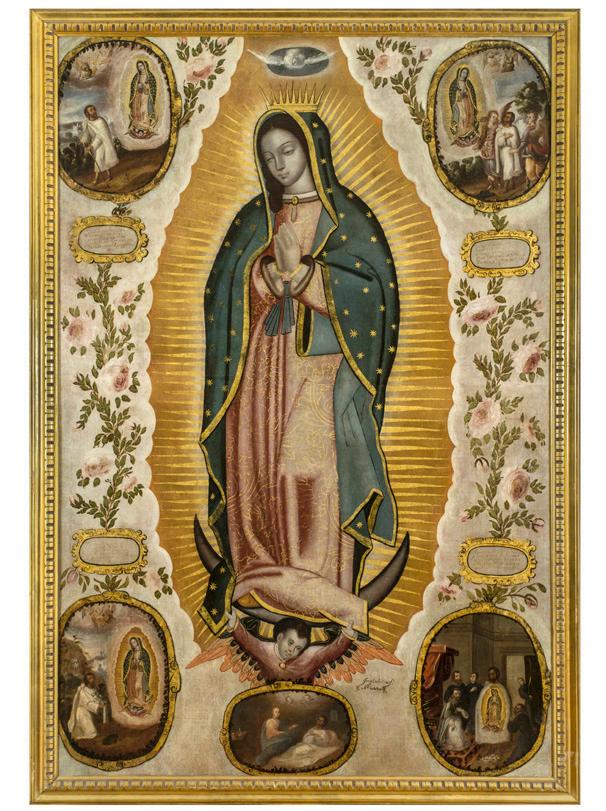
18
JAMES ROBERTS THE YOUNGER
(London, 1753 – ca. 1810)
Portrait of a Creole Woman from Lima
Inscribed, lower center: Dame Créole du Pérou, vêtue selon l’usage de Lima. Signed, and dated, lower left: James Roberts, Painter to His Royal Highness the Duke of Clarence, del.ⁿ 1797.
Pen and ink with wash on paper, 11 ¾ x 8 ⅝ inches (29.8 x 21.9 cm)
This engaging drawing provides unique insight into global artistic interchange and European interest in the visual culture of the Spanish Americas in the 18th century. Its author is the littleknown British portraitist and draughtsman James Roberts the Younger, who was appointed Portrait Painter to the Duke of Clarence (later King William IV) as indicated in his prominent signature. Dated 1797, this work was drawn after a 1774 engraving by the French artist FrancoisRobert Ingouf that reproduces a portrait of a criolla woman—of Spanish descent but born in the New World—by the Peruvian artist Julián Dávila (ca. 1736–1821). Interestingly, the artist only adopted the surname Dávila later in life and is better known by his birth name, Julián Jayo (full name Julián Jayo Apumayta Taurichumbi Sabá Mango Cápac Inga). Jayo was born in Lima and belonged to a noble indigenous lineage. He became Cacique of Lurín and Pachacamac through family inheritance, and later was one of the signers of the Peruvian Act of Independence in 1821. Although there were many indigenous workshops in Peru during the Colonial period, many painters’ names have been lost and their works remain anonymous. Jayo stands out as a documented indigenous artist who achieved considerable success in Lima, where he painted for the city’s secular and ecclesiastical elite. Few of his paintings are known today, and it is uncertain whether the portrait recorded in Ingouf’s print and this drawing still survives. The painting depicted here is a testament to Jayo’s refined style and provides a rare example of an independent female portrait in late Viceregal Peru, punctuated by the elegant table, colonial silver, and other luxury objects.
19

20
ITALIAN SCHOOL, ca. 1800
Head of a Young African Man
Polychrome terracotta
9 x 8 ⅝ inches (23 x 22 cm)
This intriguing and enigmatic sculpture depicts the head of a young African man emerging from a circular opening or window. He is seen in three-quarter profile, his eyes partially closed, but with a resolute expression punctuated by his surging hair. He seems neither an allegorical figure, nor an ethnographic type. Were it not for the highly unusual format, the specificity of his features would suggest that he is the subject of a portrait. The function of the work remains a mystery. Its scale, material, and degree of finish suggest that it was a model for a larger work—whether an architectural ornament, an element of a multi-figure composition, a funerary or commemorative monument, or some grand sculptural project. As an individual head seen in isolation it seems to evoke a range of associations—resignation, resistance, solitude. And the visual ties to images of the head of Saint John the Baptist on a salver, whether or not intended by the artist, gives additional resonance to the piece. The octagonal surround as well as the inner frame are integral with the head, and as the work does not correspond to any familiar class of object—whether artistic, decorative, or utilitarian—it seems likely that our sculpture could have been retained in the studio of the unknown artist who modeled it. On the basis of its high quality and style, we have suggested that it is Italian of the late 18th or early 19th century, but as with its purpose, its origin and date remain to be discovered, although its beauty can be appreciated despite the lack of art-historical context.
21
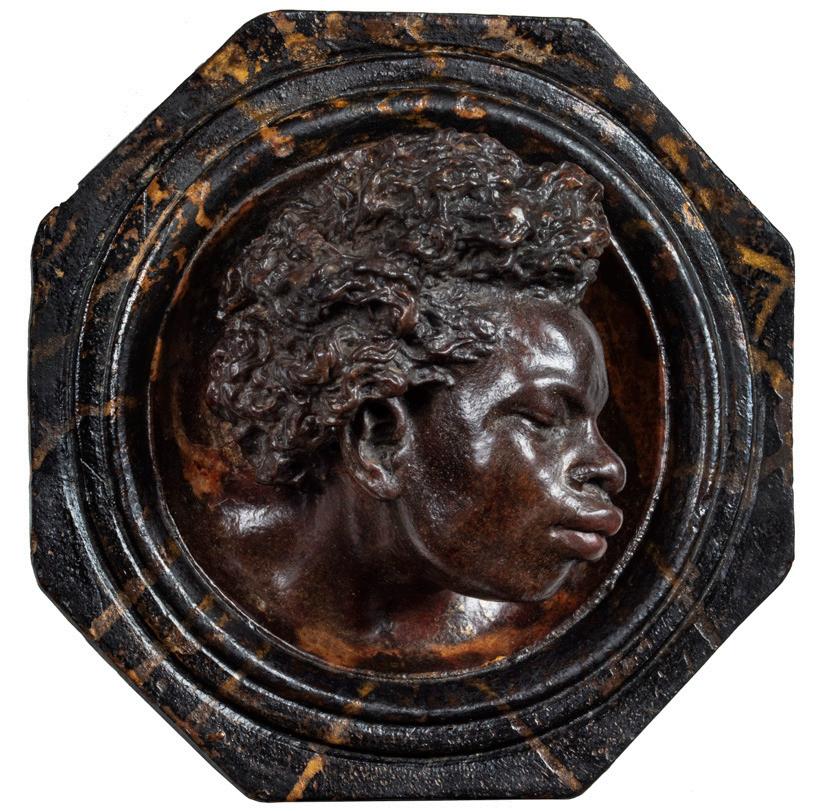
22
JOSHUA JOHNSON
(American, ca. 1763 – after 1824)
Portrait of a Woman
Joshua Johnson was the first free Black painter to establish a professional career in the United States. He was born into slavery—the son of an unknown Black woman enslaved by William Wheeler Sr., and a white man, George Johnson. George purchased his young child, described in the bill of sale as a “mulatto boy named Joshua,” from Wheeler in 1764. The 1782 manumission order for Joshua reveals that he was aged nineteen when his father granted his freedom. The document records that George acknowledged Joshua to be his son and arranged to free him upon completion of his apprenticeship to a blacksmith or when he turned twenty-one, whichever came first. The details of Johnson’s artistic training are few, but he was listed as a limner, or portrait painter, in the Baltimore City Directory beginning in 1798. Two years later he proudly described himself in an advertisement in the Baltimore Intelligencer as “a self-taught genius” who had “experienced many insuperable obstacles in pursuit of his studies.” Johnson specialized as a portraitist and was active primarily in Federalera Baltimore, where he captured the likenesses of the city’s elite. Only around 80 of his paintings have survived, of which his independent female portraits are most rare and prized. The unknown sitter is here presented in a format that was common in Johnson’s portraits of women—half-length, seated, and posed in three-quarter profile. The work includes several of Johnson’s signature attributes, including the sitter’s swooping curls of hair, the open book held between her thumb and index finger, and the elegant chair on which she sits. Although unidentified, the subject of this portrait was undoubtedly a prominent member of Baltimore society, as indicated by her fashionable yelloworange Empire dress with puff sleeves, head scarf adorned with a white bow, lace “chemisette” topped by a ruffled collar, and her prominent pendant earring and gold ring. Johnson’s hand is here apparent in the delicate lines that define and emphasize the sitter’s features and garments, as well as in the underdrawing visible beneath the thinly applied paint, both characteristic of the artist’s technique.
Oil on canvas 24 ¼ x 22 ½ inches (61.5 x 57.1 cm)
23
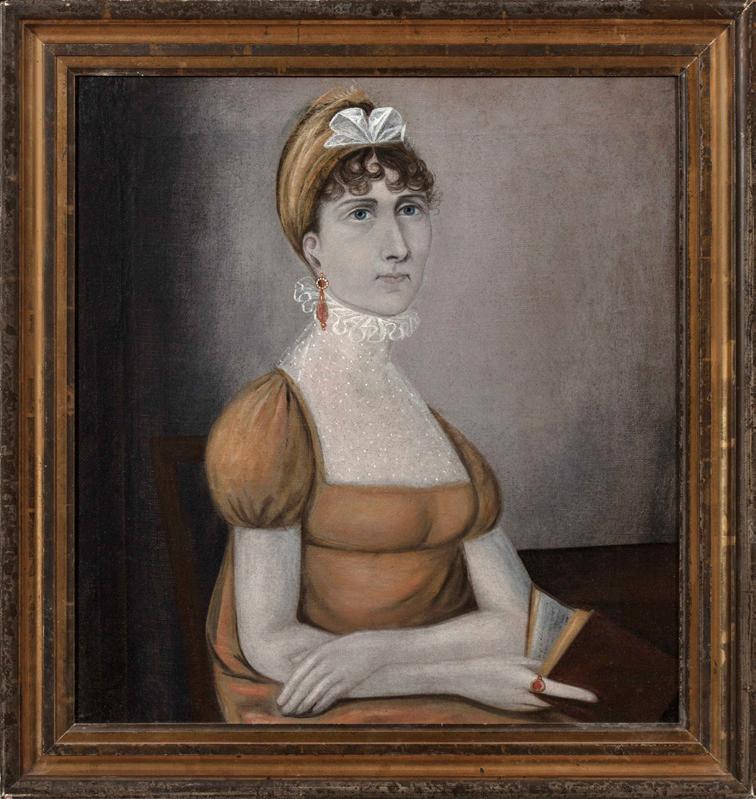
24
CARIBBEAN, ST. CROIX, 19th Century
John Gottliff, known as General Buddhoe
Inscribed on the interior, Gen/ Buddo, and incised H (possibly a maker’s mark)
Bone
4 ½ x 1 ¾ inches (11.4 x 4.4 cm)
This curious and compelling statuette depicts one of the lesser-known figures in the history of emancipation in the Caribbean. John Gottliff, or John Gottliff Bordeaux, as he was at times called, was born enslaved in 1820 on Estate La Grange, a sugar plantation near Frederiksted on the island of St. Croix. At around the age of twenty-seven, Gottliff was involved in the July 3rd, 1848 uprising on St. Croix that led to the abolishment of slavery across the Danish West Indies. A mass demonstration of thousands of people led Governor General Peter von Scholten to declare the freedom of all enslaved people in the Danish possessions of St. Croix, St. John, and St. Thomas with a single proclamation. Gottliff came to be known as General Buddhoe (likely a corruption of Bordeaux) for his role in the 1848 events. While the exact circumstances of the revolt and the degree of Gottliff’s involvement remain disputed, he is remembered and memorialized on St. Croix as the leader and the face of the uprising. What is certain is that in the days following July 3rd, Gottliff traveled around the countryside in an attempt to maintain peace, urging the newly freed to lay down weapons and cease pillaging. He was arrested and imprisoned by the Danish authorities, and although he maintained that he was not a leader of the revolt, was exiled from St. Croix without trial. He eventually settled in New York City, where he is documented in 1850 as working in a shipping office and as the keeper of a boarding house. Our statuette, fabricated by an unknown St. Croix artisan out of local bone, is actually hollow with a small flap that opens in the rear of the jacket. It has been suggested that the interior of the work could accommodate a small nut, stone, or object associated with an Afro-Caribbean animist religion, such as Santeria.
25

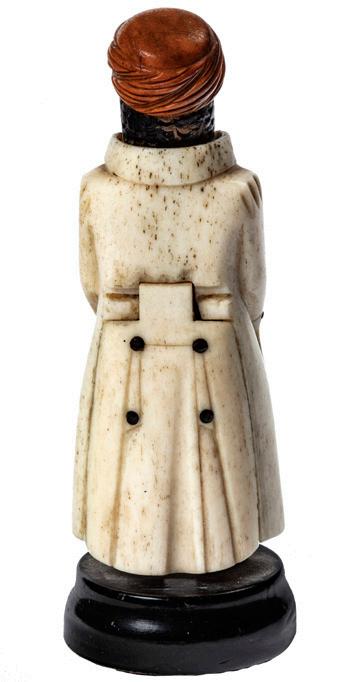
26
Circle of JULIEN HUDSON
(New Orleans, mid-19th Century)
Portrait of a Youth
Oil on canvas
12 x 8 ⅞ inches (30.5 x 22.5 cm)
This intriguing portrait of a mixed-race young man is closely related to the portraiture of Julien Hudson, one of the earliest free painters of color in America, second only to Joshua Johnson. Hudson was born in New Orleans and is thought to have first trained locally before studying twice in Paris, including with a pupil of Jacques-Louis David. His principal period of activity was from 1831, when he opened a studio on Bienville Street, until 1844, when he died prematurely at age 33. Only five paintings by him are signed, including his Creole Boy with a Butterfly of 1835, to which our painting bears a striking resemblance. The youths in each of these works have short curly hair, dark eyes, and share a similar complexion. They are both posed in three-quarter profile and are dressed in the formal attire of adults. Our sitter, seen against a bright blue sky (typical of Hudson’s paintings) confidently grasps his jacket lapel as he engages the viewer. His age is indeterminate, but his quiet resolve suggests a character beyond his years. A thriving community of free people of color existed in early 19th-century New Orleans, unique in the American South. Within that community Hudson was patronized by both white and mixed-race clients and is known to have taught students as well, although their identities remain largely unknown.
27
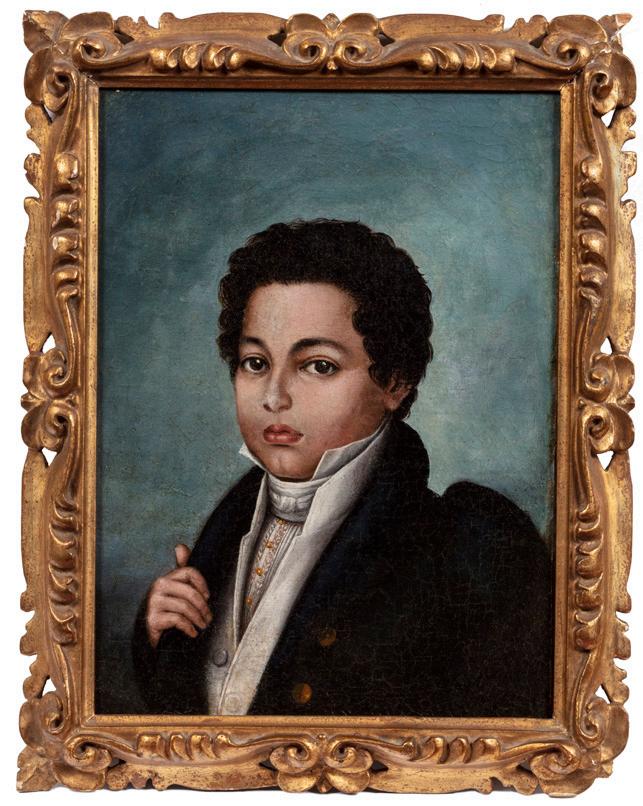
28
DAVE, later recorded as DAVID DRAKE
(American, ca. 1801 – 1870s)
Eight-Gallon Storage Jar
Signed and dated: Lm/ Decr 17. 1857/ Dave
Alkaline-glazed stoneware, 16 x 16 inches (40.6 x 40.6 cm)
Monumental in scale, beautifully glazed, and remarkably inscribed, the storage jars produced by David Drake rank among the most important works of American stoneware of the 19th century. This is due not only to Dave’s technical prowess at throwing clay or the ambition that led him to create jars of such size—larger than any other known from the American South—but also for the voice that these works transmit to us. Dave was born enslaved around the turn of the 19th century and was not freed until the Emancipation Proclamation, after which he seems to have adopted the surname of one his former enslavers, Harvey Drake. Despite strict laws in South Carolina that forbade instructing enslaved people of African descent to read and write, Dave was not just literate, but poetic. He signed and dated many of his vessels with cursive script incised in the wet clay, and in some cases, included verses of rhyming couplets. These range from the self-referential—remarking on the size, use, or making of his wares—to the personal and powerful, as his words record the lived experience of enslavement. His verse “I wonder where is all my relation/ Friendship to all—and every nation” has been recognized as one of the most moving expressions in the history of American letters. This exceptional storage jar dates from the height of Dave’s production, between 1857 and 1860, when he was making his largest and most poignantly inscribed works. It is prominently signed by Dave with the date of creation and “Lm,” denoting Lewis Miles, his enslaver and the owner of the pottery, the Stony Bluff Manufactory, in the Old Edgefield District of South Carolina. The jar stands out for its exceptional condition, beautifully proportioned shape, and the exquisite poured wash of alkaline glaze. Many have pondered the question of whether objects produced forcibly by enslaved labor can rightly be called art. But as both a brilliant wordsmith and skilled turner—two creative pursuits that are literally fired together into his vessels—Dave realized works of great artistry that conveyed his personal expression despite and in defiance of his circumstances.
29
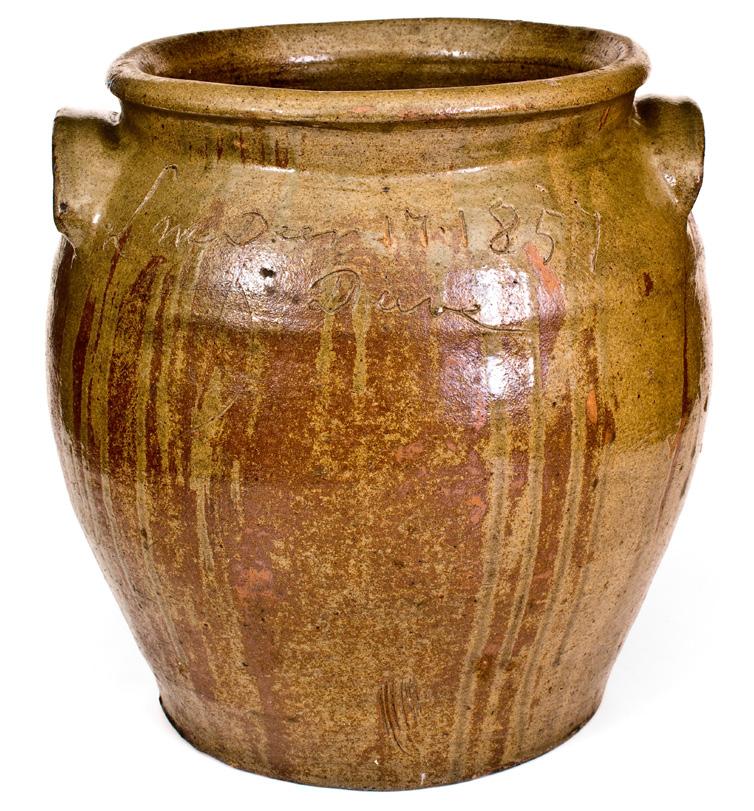
30
PERUVIAN SCHOOL, ca. 1800
Saint Martín de Porres
Oil on canvas, laid down on board
33 x 27 ¼ inches (83.8 x 69.2 cm)
Martín de Porres was born in Lima in 1579, the illegitimate son of a Spanish-American father, Juan de Porras, and Ana Velázquez, a formerly enslaved woman of African descent from Panama. Abandoned by his father, Martín grew up in poverty. He was apprenticed to a barber-surgeon, but soon entered the Dominican Convent of El Rosario in Lima, first as a servant, then an almoner, and eventually a lay brother. While his African ancestry prohibited his taking full orders, a life of profound devotion, care for the sick, and extreme acts of charity was accompanied by miracles that led to widespread popular veneration after his death in 1639, beatification in 1837, and canonization in 1962. Today Martín de Porres is the patron saint of mixed-race people, barbers, health workers, and those seeking racial harmony in the Catholic Church. He is also known as Papa Candela in the Afro-CaribbeanCatholic syncretist religion of Santeria. No contemporary portrait of Martín de Porres is known, but the earliest images of him from the late 17th century share the same iconographic features seen in this work, painted by an anonymous Peruvian artist around 1800. He is depicted as a young man wearing a Dominican habit, the black-and-white colors also thought to allude to his mixed-race origins. The future saint has a halo reflecting popular veneration of him, and he is seen within in his cell at El Rosario (now the Basilica of Santo Domingo) with a tree visible through a barred window. A red curtain is pulled aside, revealing a shelf with bottles containing the cures that he would administer to the ill. The broom that leans against the wall nearby is Martin’s traditional symbol and reflects the menial work performed by a good part of the free and enslaved Afro-Peruvians that then comprised nearly 50% of Lima’s population. He wears the rosary, to which his convent was dedicated, and carries a basket of bread, denoting saintly charity, both associated with the Dominican Order. Martín’s love of animals is illustrated not only by his feeding of birds at the right, but by the unusual and charming vignette at the lower left. There a hungry cat, a dog, and a mouse peacefully share a bowl of soup brought by the saint, who famously tells them: “Coman y callen y no riñan” (“Eat, be quiet, and don’t squabble”).
31

32
PERUVIAN, AYACUCHO SCHOOL, 18th–19th Century
The Three Magi Huamanga stone
7 ½ x 6 ½ inches (19 x 15.2 cm) each
Known as Peruvian alabaster for its translucency and workability, Piedra de Huamanga is a highly prized material from the province of Ayacucho in Peru. In the 17th and 18th centuries, local craftsman in the town of Huamanga began to specialize in the production of small-scale, polychrome religious sculptures made from this distinctive stone. Huamanga sculptures are among the most accomplished examples of carving from the Spanish Americas, where polychrome wood sculpture was a far more common sculptural medium. These works, which were created as independent sculptures or as sculptural groups—such as our three Magi—were intended for ecclesiastical as well as domestics settings. Our three figures likely formed part of a larger Nativity group—a New World variant of the tradition of the Neapolitan Crèche. Melchior, Balthasar, and Caspar each carry their gifts of gold, frankincense, and myrrh, as specified in the Gospel of Matthew. But the lands from which they traveled and the animals which brought them to Bethlehem are not identified in the Bible. Here the anonymous artist of our figurines has followed a popular tradition that became current in the Renaissance, in which the eldest of the three kings, Melchior, was thought to be from East Asia; the middle magus, Caspar, from Arabia; and the youngest, Balthasar, from Africa. They travel on appropriate modes of transportation: a horse for Melchior, a camel for Caspar, and an elephant for Balthasar, slow as it might make the journey. The natural warm white color of the stone is retained for the three animals and for the skin of the Magi, save for Balthasar whose face, arms, and hands have been delicately painted. With the exuberantly colored robes and hats worn by the Magi, these figures are charming celebrations of the Feast of the Epiphany.
33
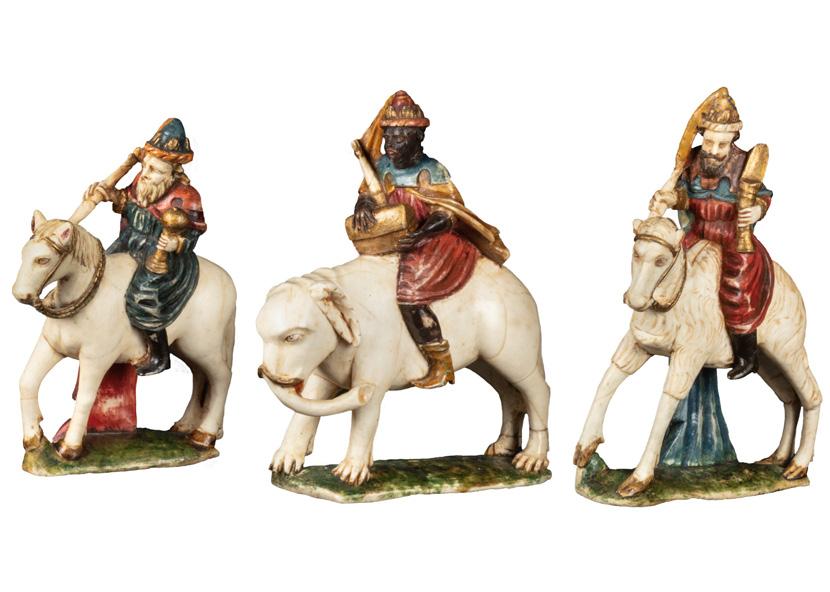
34
DOMENICO PAGANO
(Polizzi Generosa, 1851 – 1912)
Portraits of a Berber Girl and Boy
Signed and dated on the reverse of the girl: Pagano/ 1893
Polychrome terracotta
23 ⅝ x 17 ⅜ inches (62 x 45 cm) each
These striking polychrome busts are the work of Domenico Pagano, a little-known but manifestly accomplished 19th-century sculptor from Palermo. Although there are few details of his life and artistic training, Pagano had both a national and international career as an artist, exhibiting works at major exhibitions throughout Italy in the 1880s and 90s, as well as in London and Paris. While he is recorded as a formal portraitist—his portrait of Cavour is in the Galleria d’Arte Moderna in Rome—his most appealing works depict children, most often from North Africa. It is not known whether Pagano traveled there or whether his subjects were among the many African, largely Tunisian, residents in Palermo. Notably, Pagano portrayed his subjects in their native garb, but with a minimum of the exoticizing accessories that often characterize Orientalist works of the period. The artist’s portrayal of his subjects in these two busts, a handsome Berber (or Imazighen) girl and boy, focuses on their personalities and expressions, while their dress and ornamentation, such as the coin necklace of the girl or the chechia hat worn by the boy, are relatively subdued. These figures are entirely sympathetic, and the accomplished technique of the artist, particularly the realistic polychromy and the contrasting of smooth and rough textures, conveys a sense of reality that reinforces their appeal.
35

36
PREVIOUS SALES
JUSTUS SUTTERMANS
(Antwerp 1597 – 1681 Florence)
Domenica delle Cascine, la Cecca di Pratolino, and Pietro Moro, Three Servants of the Medici Court
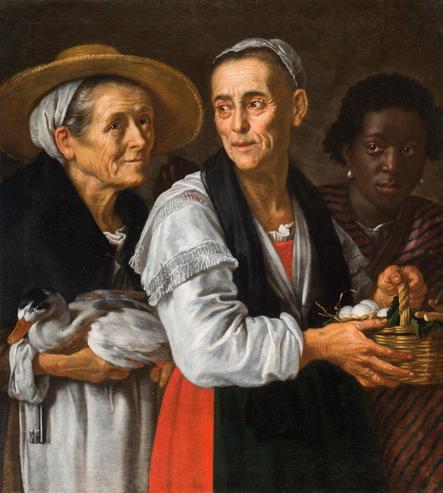
AUGUSTIN EDOUART

(Dunkerque 1789 – 1861 Calaid)
Portrait of Joseph H. G. Anderson, Leader of Frank Johnson’s Band, an all-Black Philadelphia-based brass ensemble
Saint Louis Art Museum
Philadelphia Museum of Art
Circle of GOVAERT FLINCK (Dutch, 1615 – 1660)
Portrait of a Woman

Walters Art Museum
ITALIAN, VENETIAN SCHOOL, ca. 1600
Portrait of a Man
Brooklyn Museum

Attributed to JEAN-BAPTISTE-JACQUES
AUGUSTIN
(French, 1759 – 1832)
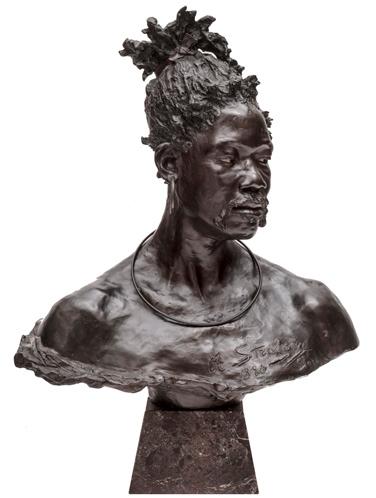
Study of a Man
Flint Institute of Arts
ARTHUR STRASSER
(Austrian, 1854 – 1927)
Portrait of a Man
High Museum of Art
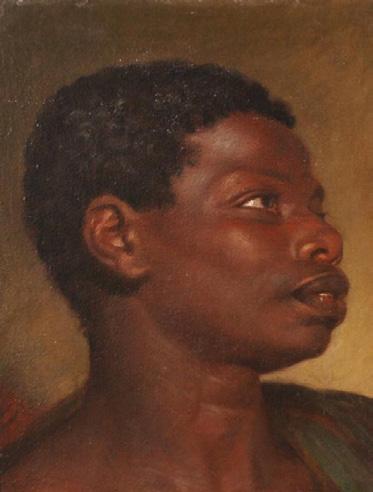
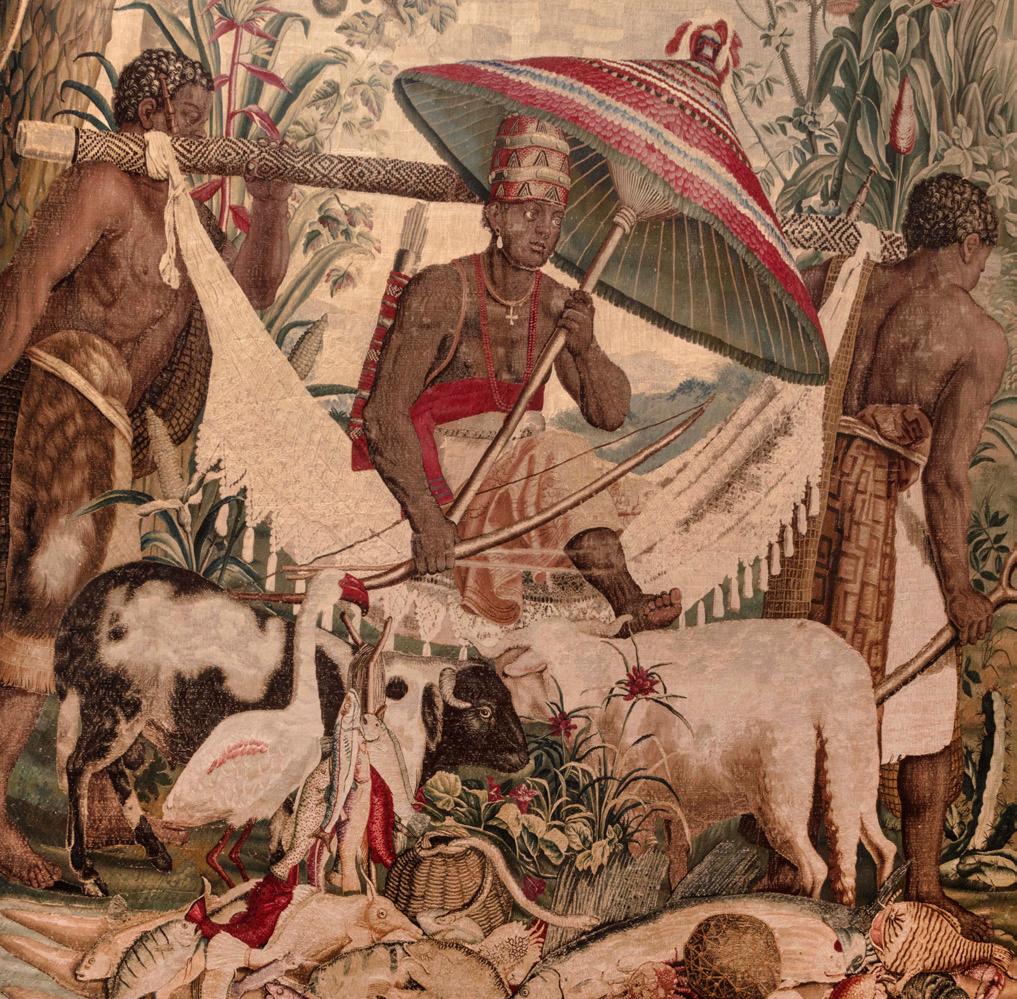

WWW.ROBERTSIMON.COM


































